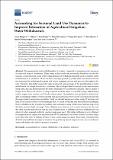| dc.description.abstract | The assessment of water withdrawals for irrigation is essential for managing water resources in cultivated tropical catchments. These water withdrawals vary seasonally, driven by wet and dry seasons. A land use map is one of the required inputs of hydrological models used to estimate water withdrawals in a catchment. However, land use maps provide typically static information and do not represent the hydrological seasons and related cropping seasons and practices throughout the year. Therefore, this study assesses the value of seasonal land use maps in the quantification of water withdrawals for a tropical cultivated catchment. We developed land use maps for the main seasons (long rains, dry, and short rains) for the semi-arid Kikuletwa catchment, Tanzania. Three Landsat 8 images from 2016 were used to develop seasonal land use land cover (LULC) maps: March (long rains), August (dry season), and October (short rains). Quantitative and qualitative observation data on cropping systems (reference points and questionnaires/surveys) were collected and used for the supervised classification algorithm. Land use classifications were done using 20 land use and land cover classes for the wet season image and 19 classes for the dry and short rain season images. Water withdrawals for irrigated agriculture were calculated using (1) the static land use map or (2) the three seasonal land use maps. Clear differences in land use can be seen between the dry and the other seasons and between rain-fed and irrigated areas. A difference in water withdrawals was observed when seasonal and static land use maps were used. The highest differences were obtained for irrigated mixed crops, with an estimation of 572 million m3/year when seasonal dynamic maps were used and only 90 million m3/year when a static map was used. This study concludes that detailed seasonal land use maps are essential for quantifying annual irrigation water use of catchment areas with distinct dry and wet seasonal dynamics. | en_US |

